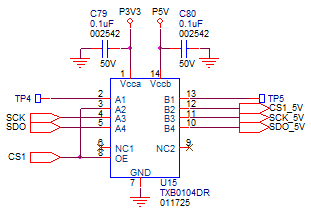Other Parts Discussed in Thread: SN74LV4T125
When using TXB0104 to level shift 2.5MHz SPI from 3.3V to 5V, the 5V (See attached) output appears to have significant clock-to-data crosstalk, effectively corrupting the output, w/ only an unterminated 21" "zip" cable as a load. (Also see attached.) No improvement with the real load (SPI-controlled LEDs) connected.
The 3.3V inputs are from a Microchip DSPIC33EP128MC506, and are clean.
This was originally posted to tech support as case CS0034489, & they referred me here.






